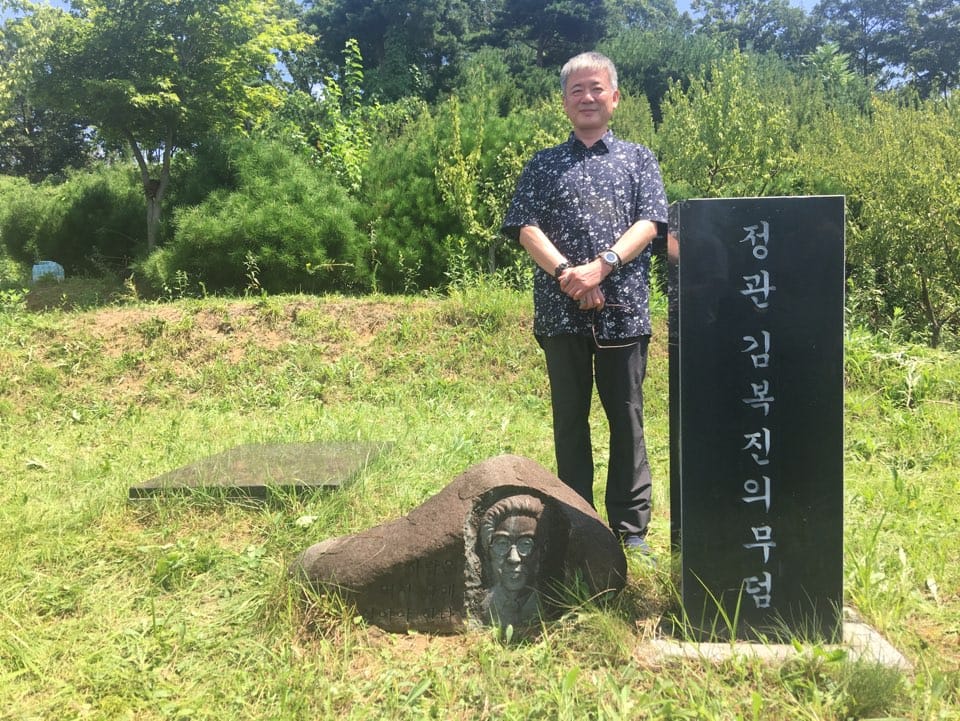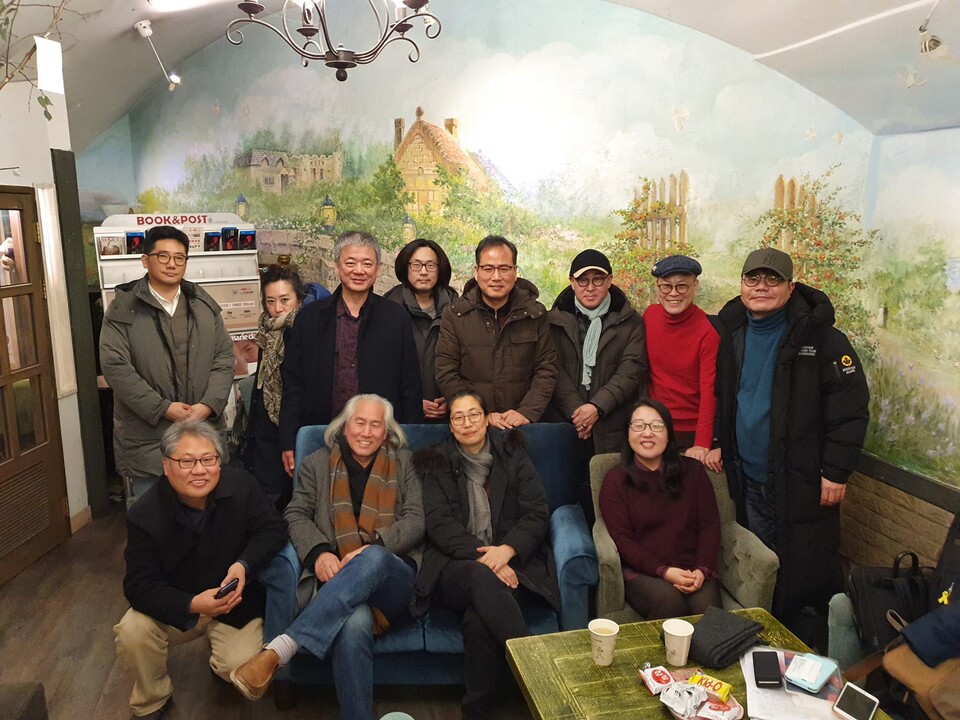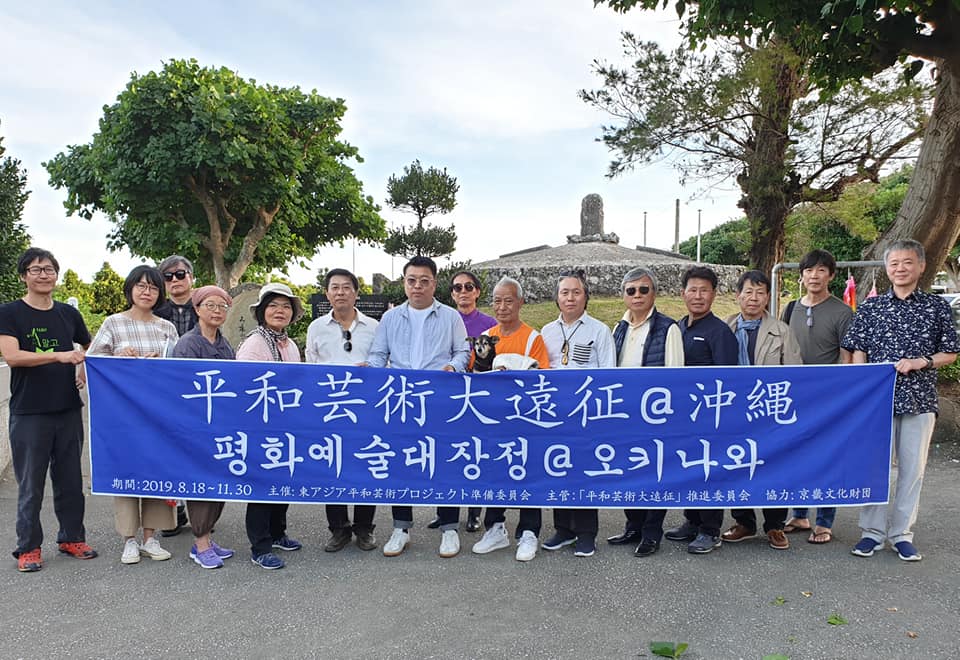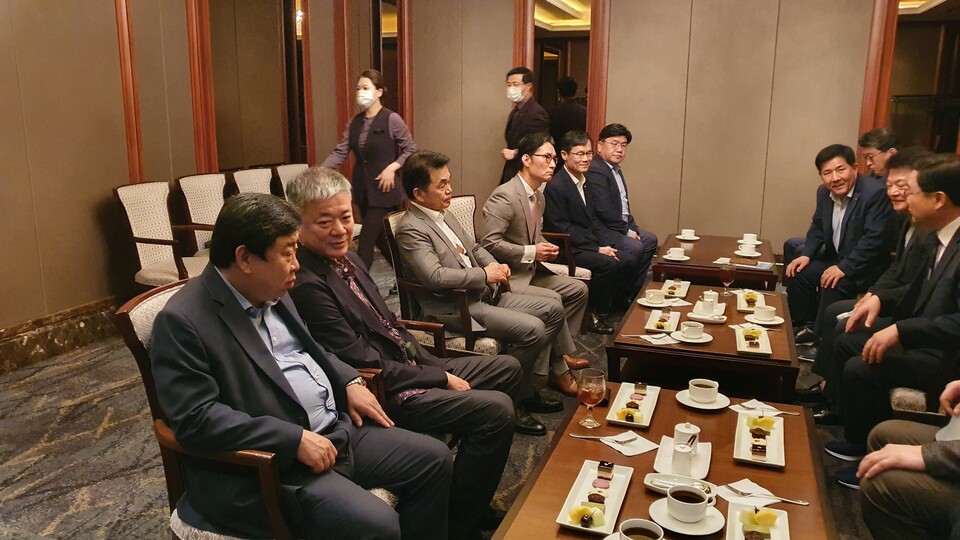[평화예술칼럼 Peace Art Column] (95) 김준기
제주도는 평화의 섬입니다. 항쟁과 학살의 역사를 가지고 있기에 평화를 염원하는 마음은 더욱 간절할 수 밖에 없습니다. 제주4.3이 그렇듯이 비극적 전쟁을 겪은 오키나와, 2.28 이래 40년간 독재체제를 겪어온 타이완도, 우산혁명으로 알려진 홍콩도 예술을 통해 평화를 갈구하는 ‘평화예술’이 역사와 함께 현실 속에 자리 잡고 있습니다. 이들 네 지역 예술가들이 연대해 평화예술운동을 벌이고 있습니다. 이들의 평화예술운동에 대한 창작과 비평, 이론과 실천의 공진화(共進化)도 매우 중요합니다. 독립언론 [제주의소리]가 네 나라 예술가들의 활동을 ‘평화예술칼럼(Peace Art Column)’을 통해 매주 소개합니다. 필자 국적에 따른 언어가 제각각 달라 영어 일어 중국어 번역 원고도 함께 게재합니다. [편집자 글]
꽃상여 타고 / 그대 잘 가라
세상의 아름다운 꿈을 / 꾸다 가는 그대
김종선 선생
2021년 9월 30일. 갑작스런 비보를 접하고 어찌할 줄 몰랐던 나는 그의 장례식 웹자보를 공유하며 이런 노랫말을 올렸다. 그는 세상의 아름다운 꿈을 꾸다 갔다. 그의 꿈은 무엇이었을까? 어떤 꿈을 향해 그렇게도 치열하게 한 평생을 이리로 또 저리로 내달렸던 것일까?
어느덧 1년의 시간이 흘러 그를 기억하는 사람들이 모이는 ‘김종선1주기추모제’(9월 30일, 금요일, 17:30, 자하미술관)가 열린다. 나는 학생운동과 공직, 예술인단체 활동에 걸친 그의 삶이 정치와 예술이 만나는 그 어떤 지점일지도 모르겠다는 생각으로, 김종선을 회고하며 몇 가지 시사점을 떠올려보고자 한다.

김종선은 문화정책가로서 불리며 수많은 활동을 했다. 사회생활을 시작할 때 그는 어공, 즉 어쩌다 공무원이 된 사람이었다. 최희준 의원의 보좌관으로서 국회 공직자 활동을 한 그는 영화 검열 폐지, 민관협치기구 영화진흥위원회 창설, 문화벤처 육성, 음악과 게임 등 한류 기틀 조성 등을 의원입법으로 처리하는 데 실무자로서 맹활약했다. 이후 그는 15대 대통령직 인수위원회 문화정책담당 행정관(2003년)을 지낸 후, 문화관광부 이창동 장관 정책보좌역으로서 문화행정 혁신위원회 간사로서 일했다. 참여정부 시절의 급변하는 정세를 헤아리며 그는 대한민국 정부의 문화정책 최전선에 서 있었다.
“정치와 예술 현장에서 20여년을 지켜왔다. 2020년은 다시 출발을 의미한다. 한국민예총 사무총장의 직무와 세상을 위한 꿈을 함께 이뤄갈 것이다. 새 민주주의를 위하여~”
김종선이 자신의 페이스북 담벼락 첫머리에 올려둔 글이다. 그의 말대로 김종선은 1990년대말부터 20여년동안 한국의 정치와 예술 현장 최전선에 서 있었던 사람이다. 그는 국회와 문화부, 문화재단 등에서 보좌관이나 행정관, 간사, 이사로 활동하면서 한국의 문화정책을 이끌어나간 문화행정 전문가다.
그랬던 그가 공직이 아닌 민간단체 영역에서 활동한 것이 지난 몇 년 간의 일이다. 50대 중반의 그는 민예총 사무총장을 역임하면서 예술현장의 변화를 이끌고자 헌신적인 노력을 기울였다. 오랜 기간 공직에 몸담거나 공공영역의 활동을 통하여 문화정책기획자라는 직함으로 활동해온 김종선에게 민예총 일은 정체성의 변화를 가져다주었다. 그는 문화에서 예술로 패러다임 전환을 선언했다. 어느 세미나에 토론자로 참석한 그는 다음의 글에서 문화와 예술의 차이를 명확하게 밝히고 있다.

“‘문화예술’은 ‘문화’의 가치를 훼손합니다. 유럽연합은 ‘문화’의 가치가 사회에 반영 되도록 공공 조달 입찰 과정에서 “화해, 갈등해결 및 민주화의 맥락에서”라는 표현을 사용하도록 장려하고 있습니다. 이에 반하여 예술가는 정치적 신념에 관계없이, 예술행위를 함으로서 혼란을 야기합니다. (김지하, 현기영, 오윤, 김민기가 그러하였듯이) 예술가는 현재 통용되는 표상에 의문을 품고 문제를 제기할 뿐 아니라, 자신이 생각하고 느끼는 바를 있는 그대로 진실하게 직면합니다. 그래서 그들은 현실에 균열을 일으키고, 감상자들을 불안하게 만들며, 다양한 현실이 구현될 수 있도록 가능성을 높입니다. 예술가는 우리가 보지 못하는 틈새의 프레임을 제공하는 것입니다.”
20여년을 문화정책이라는 화두로 살아온 그가 문화와 예술의 차이를 논하며, 지난날 자신이 걸어온 길에서, 그 차이를 명확히 하지 못한 것을 후회하는 발언을 하기도 했다. 그는 문학 서클 활동을 문화패로 규정하고 문화운동을 했으며, 문화산업진흥기본법을 기안하면서 문화산업을 주창했다. 김종선은 자신의 활동을 문화정책이라고 생각했으며, 예술정책의 관점을 세우지 못했던 것은 사고의 부재로 인한 한계였다고 술회했다.
그는 한국현대사에서 권력에 맞섰던 예술을 문화운동이 아닌 사회참여 예술활동으로 재규정하고자 했다. 이 대목은 그가 예술인단체 활동을 하면서 문화정책에서 예술정책으로 전환한 이후의 일이다. 예술인 정체성을 탑재한 그는 관의 경험을 토대로 민의 위치를 재구성하거나 민관 협치의 장을 열기 위해 열정적으로 움직였다.
하지만 그의 운명은 더 이상의 열정을 허락하지 않았다. 코로나19 백신 후유증으로 인한 건강 악화로 그는 50대 중반의 젊은 나이에 저 세상으로 떠났다. 그가 떠났을 때 그동안 예술계에서 있어본 적이 없는 일이 벌어졌다. 예총과 민예총이라는 양대 예술인 단체가 그의 장례를 공동으로 주관한 것이다. 한국의 사회 전반이 그러하듯 예술계에도 깊게 패인 좌우의 진영논리를 넘어서고자 했던 김종선의 큰 걸음이 빛을 발하는 대목이었다.
그는 문화와 예술, 공공의 정책과 민간의 운동, 관료와 예술인, 정치와 예술, 86세대 이전과 이후 등 서로 다른 진영의 이원적 요소들을 연결하고 소통하는 데 탁월한 실력을 발휘한 예술활동가이다. 적잖은 세월을 어공으로 살아온 나는 관과 민을 아우르는 김종선의 저 유연함과 강인함을 존경해왔다. 경기문화재단 주최의 ‘동아시아평화예술대장정’(2019)의 일환으로 오키나와를 비롯한 여러 도시들을 여행하면서 그와 나눈 꿈들은 생명과 평화를 향한 도도한 예술의 밑그림이었다.


한 때 정당 창당에 가담하기도 했을 정도로 정치의 중요성을 실감했던 김종선은 문화에서 예술로의 전환 이후, 정치와 예술을 연결하는 큰 그림을 그리고 있었다. 그것은 정치도구로서의 예술과 같은 낮은 수준의 것이 아니라, 예술의 정치성에 주목한 것이었다. 그것이 순수주의를 표방하던 참여주의를 지향하던 간에, 예술은 그 자체로 사회적인 영향력을 발휘한다는 점이 중요하다.
1년 전 갑작스럽게 우리 곁을 떠난 그의 삶을 돌아보며 김종선이 꾸었던 아름다운 꿈은 민주주의와 생명평화를 향한 예술의 꿈이었음을 다시 생각한다.
# 김준기

홍익대학교 예술학 학사, 석사, 미술학 박사. 한국큐레이터협회 회장, 미술평론가.
전(前) 부산비엔날레 전시기획팀장, 부산시립미술관 큐레이터, 대전시립미술관 학예연구실장, 제주도립미술관 관장, 국립현대미술관 학예연구실장
Riding on the mourning palanquin of flowers/You, farewell.
The beautiful dream of the world / You who sees and goes/ KIM Jongsun
On 30 September 2021, not knowing what to do with the sudden sad news, I posted the lyrics on the website. He went on dreaming beautiful dreams of the world / What were his dreams / What dreams did he run here and there all his life so fiercely?
A year has passed and those who remember him have gathered to hold the 'Kim Jongsun 1st Anniversary Memorial Service' (30 September, Friday, 17:30, Zaha Museum of Art). I would like to recall some suggestions in retrospect of his life, which spanned the student movement, public service and artists' collective activities in general, as a meeting point for politics and art.
Photo: Kim Jongsun at Kim Bok-jin's grave site. Courtesy of GIM Jungi.
Kim was called a cultural policymaker and was involved in numerous activities. When he began his social life, he was an accidental civil servant. As an aide to Rep. Choi Hee-joon, he was very active as a practitioner in public service in the National Assembly, handling the abolition of film censorship, the creation of the Film Promotion Committee as a public-private governance institution, the fostering of cultural ventures and creating a framework for Han-lyu (Korean Wave) such as music and games, including music and games, through parliamentary legislation. He later served as administrative officer in charge of cultural policy at the 15th Presidential transition Committee (2003), and worked as policy assistant to Minister Lee Chang-dong at the Ministry of Culture and Tourism, as secretary of the Cultural Administration Innovation Committee. For almost 20 years from the late 1990s, he was at the forefront of the cultural policy of the Government of the Republic of Korea, keeping abreast of the rapidly changing circumstances in the era of participatory government.
It is only in the last few years that he has worked in the realm of private organisations rather than in public office: in his mid-50s, he served as Secretary General of the General Secretariat of the Folk Art General and devoted himself to leading change in the arts scene.
After many years of working under the title of cultural policy planner, the work of the Folk Art General brought him a change of identity. He declared a paradigm shift from culture to the arts. Participating as a discussant in one of the seminars, he clarified the difference between culture and art as follows.
Photo: Kim Jongsun (third from the far left in the top row) with activists of artists' organisation. Courtesy of Gim Jungi.
―Culture Art undermines the value of 'culture'. The European Union encourages the use of the phrase “in the context of reconciliation, conflict resolution and democratisation" in public procurement tendering processes to ensure that the values of 'culture' are reflected in society. Contrary to this, artists cause disruption through their artistic acts, regardless of their political beliefs. As the artists like Kim Ji-ha, Hyun Ki-young, Oh Yoon and Kim Min-gi did, not only question and raise issues with currently accepted representations, but also express truthfully what they think and feel as they are. So they create cracks in reality, unsettling the viewer and increasing the potential for diverse realities to be embodied. Artists provide a frame for the gaps we cannot see".
Having lived on the topic of cultural policy for more than 20 years, he discussed the difference between culture and art and made remarks regretting not being able to clarify the difference on the road he has walked in the past. He defined literary circle activities as a cultural group and conducted cultural movements, and advocated the cultural industry while drafting the Framework Act on the Promotion of Cultural Industry. Kim Jongsun said that he thought his activities were cultural policies, and that the failure to establish an artistic policy perspective was a limitation due to the absence of thinking.
He tried to redefine the art that confronted power in modern Korean history as a social participatory art activity, not a cultural movement. This was after he had switched from cultural policy to art policy while he was active in artists' associations. Equipped with artist identity, he moved passionately to reconfigure the position of public opinion based on the experience of the public sector and to open venues for public-private cooperation.
But his fate did not allow him any more passion. When he passed away in his mid-50s due to deteriorating health caused by the aftereffects of a vaccine for a new coronavirus infection, something that had never happened in the art world before happened. Two major artists' organizations, the Arts Council and the Folk Art Council, jointly presided over his funeral. This was a shining example of Kim's attempt to overcome the left-right camp logic that had penetrated the art world as deeply as it had into Korean society in general.
He is an artistic activist who has excelled in connecting and communicating the dual elements of different camps, including culture and art, public policy and civilian movements, bureaucrats and artists, politics and art, and 86 generations before and after. Having lived as a fisherman for a considerable number of years, I have admired Kim Jongsun 's low flexibility and strength, which encompasses the government and the people. As part of the "East Asia Peace and Art Trip" (2019) hosted by the Gyeonggi Cultural Foundation, the dreams I shared with him while traveling to Okinawa and other cities were a rough sketch of life and peace.
Kim Jongsun (far right) who participated in the "Peace Art Expedition – Okinawa. Courtesy of Gim Jungi.
Kim Jongsun with senior artists Jang Kwang-pal (center) and Heo Sung-hoon (right). Courtesy of Gim Jungi.
Kim Jongsun, who once felt the importance of politics to the extent that he was involved in the creation of a political party, was drawing a big picture connecting politics and art after the transition from culture to art. It was not a low level like art as a political tool, but rather a focus on the political nature of art. Regardless of whether it advocates pureism or aims for participatoryism, it is important that art exerts social influence in itself.
Looking back on his life, which suddenly left us a year ago, I think again that his beautiful dream was a dream of art for democracy and life peace.
花の喪輿に乗って/君よ さようなら
世界の美しい夢を/見て往く君
金種宣(キム・ジョンスン)先生
2021年9月30日、突然の悲報に接してどうしたらいいか分からなかった私は、インターネット上でこのような詩を共有した。彼は世界の美しい夢を見て往った/彼の夢は何だったのだろうか/どんな夢に向かってあんなにも熾烈に一生をこちらへまたあちらへと走ったのだろうか。
いつの間にか1年の時が流れ、彼を記憶する人たちが集まって「キム・ジョンスン1周忌追慕祭」(9月30日、金曜日、17:30、ザハ美術館)が開かれる。学生運動と公職、芸術家団体活動全般にわたる彼の人生が、政治と芸術の出会う場所となったことを回顧しつつ、私はいくつかの示唆を想起したい。
写真:金福鎮(キム・ボクジン)廟を参るキム・ジョンスン。 提供=ギム・ジュンギ
キム・ジョンスンは文化政策家と呼ばれ、数多くの活動をした。社会生活を始めた時、彼は偶然に公務員となった人だった。チェ・ヒジュン議員の補佐官として国会で公職者活動をした彼は、映画検閲の廃止、官民ガバナンス機構である映画振興委員会の創設、文化ベンチャーの育成、音楽とゲームなど韓流の基礎形成などを議員立法で処理する実務者として大活躍した。その後、第15代大統領職継承委員会文化政策担当行政官(2003年)を務めた後、文化観光部のイ・チャンドン長官政策補佐役として、文化行政革新委員会幹事として働いた。参加型政府時代の急変する情勢を推し量りながら、1990年代末から約20年間、彼は大韓民国政府の文化政策の最前線に立っていた。
彼が公職でなく民間団体の領域で活動したのはこの数年間のことだ。50代半ばの彼は民芸総事務総長を歴任し、芸術現場の変化を導こうと献身的な努力を傾けた。長年にわたって文化政策企画者という肩書きで活動してきた彼に、民芸総の仕事はアイデンティティの変化をもたらした。彼は文化から芸術へのパラダイムシフトを宣言した。あるセミナーに討論者として参加した彼は、次のように文化と芸術の違いを明確にしている。
芸術家団体の活動家たちと一緒に参加したキム・ジョンスン(前列左から3番目)。 提供=ギム・ジュンギ
「『文化芸術』は『文化』の価値を損ないます。欧州連合は「文化」の価値が社会に反映されるように、公共調達入札過程で「和解、葛藤解決および民主化の脈絡で」という表現を使うよう奨励しています。これに反して芸術家は、政治的信念にかかわらず、芸術行為によって混乱を引き起こします。(キム・ジハ、ヒョン・ギヨン、オ・ユン、キム・ミンギがそうであったように)芸術家は現在通用する表象に疑問を抱き、問題を提起するだけでなく、自分が考えて感じることをありのまま真実に表現します。それで彼らは現実に亀裂を起こし、鑑賞者を不安にさせ、多様な現実が具現されるように可能性を高めます。芸術家は私たちが見ることができない隙間のフレームを提供するのです」。
20年余りを文化政策というトピックで生きてきた彼が、文化と芸術の違いを論じ、過去に自分が歩んできた道で、その違いを明確にできなかったことを後悔する発言をしたりした。彼は文学サークル活動を文化集団と規定して文化運動をし、文化産業振興基本法を起案しながら「文化産業」を提唱した彼は自分の活動を文化政策だと考え、芸術政策の観点をうち立てられなかったのは思考の欠如による限界だったと述懐した。
彼は韓国現代史において権力に対抗した芸術を、文化運動ではなく社会参加芸術活動に再定義しようとした。これは彼が芸術家団体活動のかたわら、文化政策から芸術政策へと切り替えた後のことだ。芸術家アイデンティティを搭載した彼は、官の経験をもとに民意の位置を再構成し、官民ガバナンスの場を開くために情熱的に動いた。
しかし、彼の運命はそれ以上の情熱を彼に許さなかった。新型コロナウイルス感染症のワクチン後遺症による健康悪化で、彼が50代半ばの若さでこの世を去った時、これまで芸術界ではありえなかったことが起きた。芸総と民芸総という二大芸術家団体が彼の葬儀を共同で主管したのだ。韓国社会全般がそうであるように芸術界にも深く入り込んだ、左右の陣営論理を乗り越えようとしたキム・ジョンスンの大きな一歩が光を放つ部分だった。
彼は文化と芸術、公共政策と民間の運動、官僚と芸術家、政治と芸術、86世代以前と以後など異なる陣営の二元的要素を連結し疎通するのに卓越した実力を発揮した芸術活動家だ。少なくない歳月を偶然の公務員として生きてきた私は、官と民を引き合わせた彼の柔軟さと強靭さを尊敬してきた。京畿文化財団主催「東アジア平和芸術大長征」(2019)の一環として沖縄をはじめとする様々な都市を旅行しながら彼と分かち合った夢は、生命と平和に向けた高尚な芸術の下絵だった。
写真:「平和芸術大長征—沖縄」に参加したキム・ジョンスン(一番右)。 提供=ギム・ジュンギ
写真:先輩芸術家のチャン・グァンパル(中央)、ホ・ソンフン(右)と一緒に参加したキム・ジョンスン。 提供=ギム・ジュンギ
一時は政党結成に加担するほど政治の重要性を実感したキムは、文化から芸術へ転換以後、政治と芸術をつなぐビッグピクチャーを描いていた。それは政治の道具としての芸術といったような低レベルのものではなく、芸術の政治性に注目したものだった。それが純粋主義を標榜しようが参加主義を志向しようが、芸術はそれ自体で社会的な影響力を発揮するという点が重要だ。
1年前、突然私たちのそばを離れた彼の人生を振り返りながら、キム・ジョンスンが見た美しい夢とは、民主主義と生命平和に向けた芸術の夢だったことを改めて考えている。
※ 중국어 원고는 추후 게재될 예정입니다.

